Written by Louise Porter, PhD, Child psychologist
Compiled by Phoenix Support for Educators Pty Ltd © 2021
TYPES OF PLAY
There are many types of play:1
※ Schematic play: in which children have a strong urge to actively explore how the world works
※ Gross (large) motor play: running, climbing, jumping, play with balls, riding bikes, swinging, and so on
※ Small motor or play with objects: play with small toys, stringing beads, playing with puzzles and sorting objects
※ Construction play: building structures using skill and imagination
※ Symbolic play, in which children use symbols (where one object stands for another) or use an object for a different purpose from its intended use
※ Make-believe, pretend or sociodramatic play, in which children use language, problem solving and imagination to rehearse future roles or process lived experiences
※ Rules-based play: making up their own games and negotiating and adapting their own or established rules
※ Language play: where children play with words, rhymes, verses, songs, and stories
※ Artistic: drawing, crafts, painting, puppet shows, music and integrating these arts into their play
※ Sensory play: playing with dirt, sand, water and various textures, sounds and smells
※ Rough-and-tumble play that helps establish the boundaries between playing and fighting
※ Super-hero play, in which children use characters (often from movies or television) to act out issues of power and powerlessness
※ Mastery play: repetition of an action until the children have mastered it
※ Risk-taking play, in which children extend their abilities in order to master challenge.
SCHEMATIC PLAY
(an extract from Featherstone, 2013)
Schematic play refers to ‘urges’ that children have to climb, throw, hide and twirl themselves and objects, in an effort to understand concepts such as gravity (‘Does everything fall every time, whenever I drop it?’), directions, and to experience movement. These schema or urges start around the first birthday, can occur one at a time, or with many together; they can persist for long periods, or be relatively brief.
The subtitle of Featherstone’s book on schema says it all: the catch-cry of children engaged in schematic learning is ‘Again!… Again!’. The children’s persistence can exceed the endurance of the adults.
When children are constantly dropping their food from their high chair, or throwing objects unsafely, these urges can be misinterpreted as a behaviour problem, when instead they are children’s very first efforts at being scientists. We can redirect them to safer variants of the same activity, such as throwing rolled up socks or bean pillows into a laundry basket or other large container, in place of throwing fragile objects or aiming at objects that can break.
Play for a child is serving just as serious a purpose as a day in the library for a research student. D. Brett (1986)
SOME TYPES OF SCHEMATIC PLAY
※ Trajectory ※ Rotation ※ Enclosing ※ Enveloping ※ Transporting ※ Connecting ※ Position ※ Orientation ※ Transformation
What we learn best from good teachers is how to teach ourselves better. John Holt
TRAJECTORY SCHEMA
This schema is all about movement. It involves waving arms and legs up and down or side to side in straight lines, dropping and throwing objects, rocking, climbing up and jumping off platforms, and stepping up and down. Children might place their hand under running water and observe where the water is diverted to, depending on the angle of their hand.
Words to support trajectory schema include: fly, spin, twirl, glide, float, drop, bounce, swing, up, down, fast, slow.
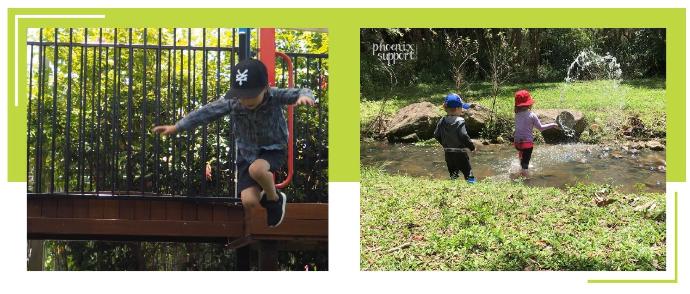
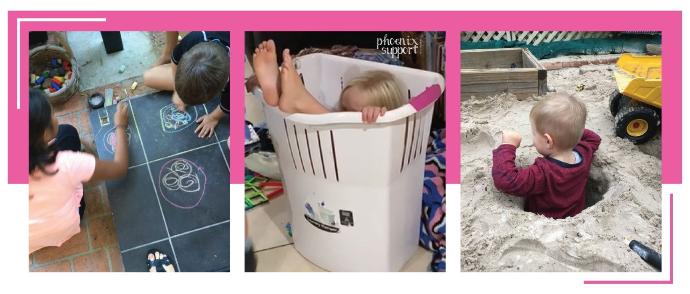
ROTATION SCHEMA
Children turn or rotate objects or themselves by spinning on the spot, twisting, rolling and turning. They are fascinated with objects that rotate, such as windmills and wheels, and their first drawings are attempts at circles (originally circular scribbles, until later when they learn to stop at the beginning of the circle). They like turning lids and watching a front-loading washing machine’s spin cycle. And they enjoy being swung around. These schema are often energetic, such as running or riding bikes round and round in circles, and twisting ribbons or scarves.
Language that supports rotational schema include: Fly, spin, twirl, round, circle, spiral, dizzy, twist.
ENCLOSING SCHEMA
Children like to form enclosures (fences or walls) around objects such as constructing fences around their toy farm animals, or placing them and other objects inside a circular train track, posting objects into an enclosure, drawing borders around their art work, arranging food around the edge of their plate, or riding a bike round and round within a boundary they have constructed.
Language that supports enclosing schema include: enclose, wrap, inside / outside, corner, side, entrance, exit, contain; size words such as bigger, smaller, longer and shorter; positional words such as on top, underneath, beside and on top.
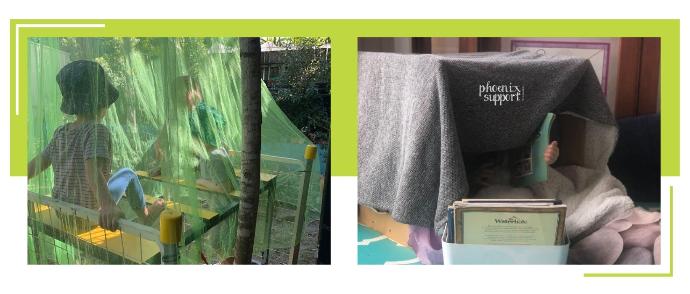
ENVELOPING SCHEMA
Young children enjoy wrapping or covering objects or themselves with different materials to hide or camouflage them. This includes dressing up in many layers, and making dens or constructing caves to climb into.
The first expression of this urge is when children and their adult play partners place a cover over a toy and then expose it, in a peek-a-boo game. That children expect it to be there is a sign that they can now conserve matter (see Cognitive development).
Words that support this schema include: under, over, visible / invisible, transparent, hidden, wrap / unwrap, full / empty.
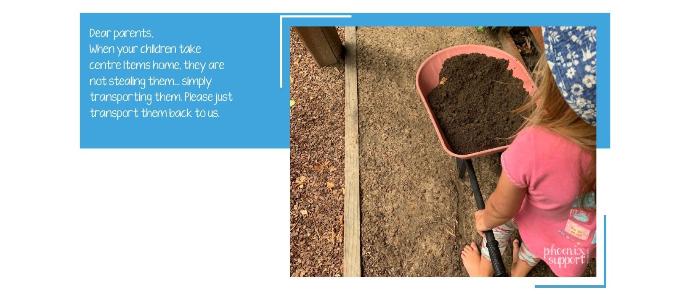
TRANSPORTING SCHEMA
Children and toddlers in particular love to move objects from place to place, in containers, their hands or pockets, or toy vehicles and then piling the objects up in their new location.
Key words that support transporting include: in, on, under, empty/full/half full, overflowing, all gone, open/closed
CONNECTING SCHEMA
This involves wanting to joining objects together, perhaps using string, tape or ribbons to build chains out of them or to suspend them from furniture or trees.
Words to use during connecting schematic play include: build, construct, join, separate, together, apart, flexible, rigid, bendy, stretchy, strong, fragile, knot, thread.
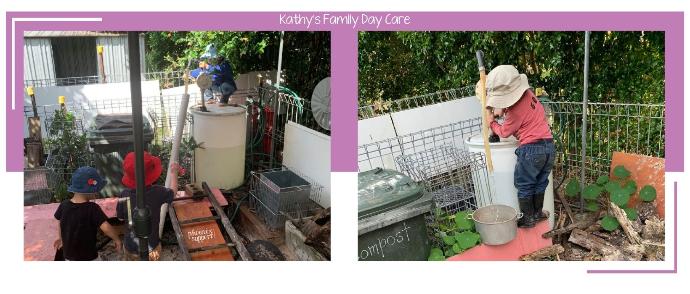
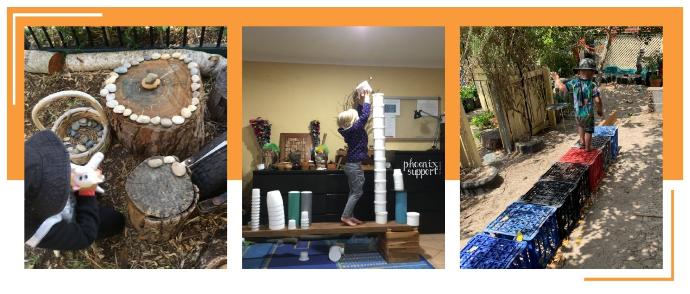
POSITIONING SCHEMA
This involves positioning, ordering and arranging objects by size, colour or shape, or placing them sometimes in an exact place. At meal times, they might not want their food to be mixed together on the same plate.
Words to support the positioning schematic play include: inside, on top, under, behind, between, next to, in front.
ORIENTATION SCHEMA
This involves looking at things from different viewpoints, such as hanging upside down, or looking through their legs. They like to build ramps and to climb in order to see things from higher positions.
Words to support the orientation schema include: turn, twist, roll, backwards, forwards, upside-down.
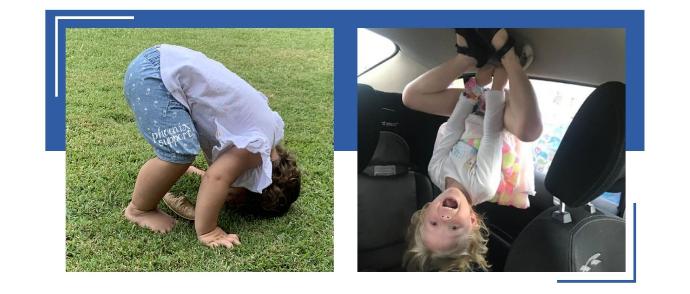
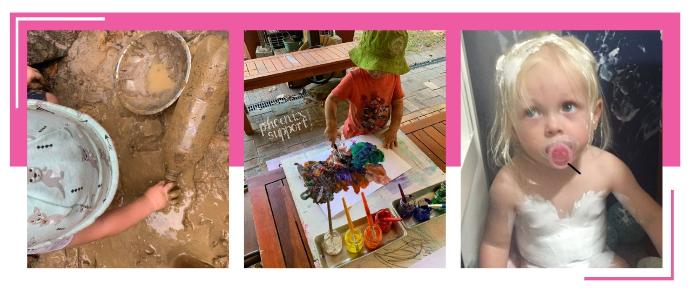
TRANSFORMING SCHEMA
This is the urge to change or transform one thing into another, exploring changes in shape, colour and consistency. Children exploring this schema might mix water with dirt to change dry into wet, or pour their drink into their food, combine paint colours, or add paint to play dough, to see what it turns into.
Words that can support this schema include wet/dry, sticky, gooey, change, transform.
Adults will need tolerance for the messiness of this form of play, reminding ourselves that it is children’s minds in action.
1 Arthur et al. 1 2015: 96-7; Miller & Almon 2009: 53-5
Thank you to the children at Kathy's Family Day Care as well as the team at Phoenix Support for Educators for your pictures of your magnificent schematic play.
DOWNLOADABLE SCHEMATIC PLAY E-BOOK WORKBOOK
You will find this content and more in a gorgeous e-book workbook which can be found inside our course - Children's Development with Dr Louise Porter. Sign up here for the next intake of this course.
WHERE CAN I FIND OUT MORE?
Several writers have made popular the ideas and research about schematic play since Piaget’s theories in the 1950s, including Chris Athey in the 80s, which inspired Cathy Nutbrown’s research and books. We recommend the following readings that provide a comprehensive overview of the literature, research, and theoretical underpinnings.
Understanding schemas and young children from birth to three by Frances Atherton and Cathy Nutbrown
Threads of thinking: Schemas and young children's learning by Cathy Nutbrown